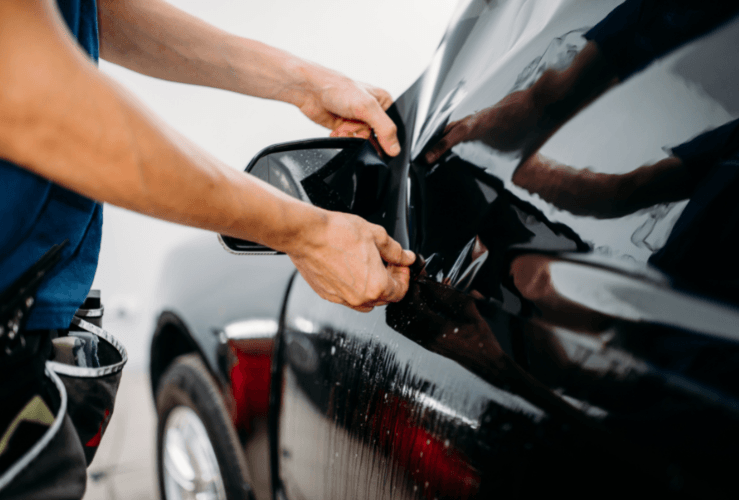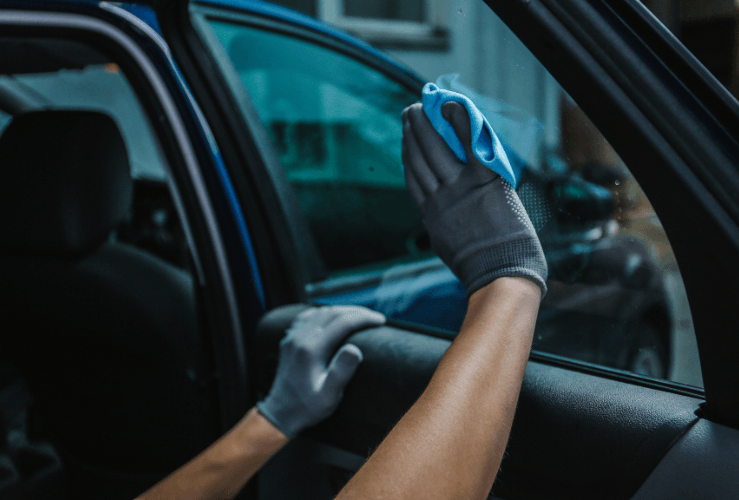Car owners have their windows tinted for a variety of reasons, including blocking UV light, improved interior cooling, reduced glare, and privacy.
Car window tint: Rules on vehicles first used on 1 April 1985
A vehicle's front side windows can be tinted to allow a minimum of 70% of the light in, while a windscreen must let in at least 75% of light.
Car window tint: Rules on vehicles first used BEFORE 1 April 1985
Both front windscreen and front side windows must allow in at least 70% of light.

Legal car window tint: Why are there limits?
When it comes to window tinting on a car, specific limits exist for reasons of road safety: a heavily tinted window will be more difficult to see out of, and so may increase the likelihood of a collision.
In low light conditions - such as dawn and dusk - it is more difficult for a driver to see the road and any potential hazards.
A U.S. Department of Transportation study [1] found that window tints with visible light transmission (VLT) below 70% significantly reduced a driver’s ability to detect pedestrians in sideview mirrors during dusk. Drivers required pedestrians to be 4.1 to 6.6 metres closer before they could be seen.
A car with tinted windows in poor light would seriously impair visibility of the road for the driver.
Front side windows are subject to specific legal limits in the UK to ensure driver visibility isn’t compromised, especially in poor lighting conditions. Always check the light transmission level before installing any new tint film to remain compliant with the law.
How do I know the percentage of tinting?
Cars sold in the UK cannot have side front windows with tinting over 70%, or windscreen tinting at over 75% - so you know any new car is completely legal.
However, the percentage varies.
The degree to which a window has been tinted can be tested with a special light sensor.
This works by placing sensors on either side of the window. The amount of light passing between the sensors is then measured.
What happens if the DVLA finds your windows are wrongly tinted?
If your windscreen or front side windows are found to be wrongly tinted - i.e. over the threshold - you could receive:
- A 'prohibition notice' - meaning you are not permitted to use the vehicle until the window tints have been removed.
- A penalty notice or court summons.
The police or Driver and Vehicle Standards Agency (DVSA) vehicle examiners can carry out this test.
Properly applied window tinting can enhance your car’s appearance, but illegal tints on the front side windows may lead to enforcement action. Always request a compliance certificate from your tinting provider to confirm your tint is within UK regulations.
Can I tint the rear windscreen or rear side windows?
There is no legislation impacting the tinting of rear windscreen and rear side windows. These can be up to 100% tint if desired.
However, it's wise to ensure you can see out of these windows for safety reasons.
By following these guidelines and understanding the rules, you can safely and legally add a touch of style and function to your car with window tints.
While rear side windows can legally be tinted up to 100%, choosing the right level of window tinting helps ensure that outward visibility remains intact. Especially when reversing or changing lanes. Consider lighter shades if visibility is a concern.
Understanding Window Tint Types
There are several types of window tint films available on the market, each offering different benefits:
- Dyed film: An affordable option that provides basic shading and glare reduction but can fade over time.
- Metalised film: Reflects heat and adds strength to the glass, but may interfere with GPS or phone signals.
- Carbon film: Offers excellent UV protection and heat rejection without signal interference.
- Ceramic film: A premium option that blocks the most heat and UV rays while maintaining clear visibility.
- Optically clear UV film: Designed to block harmful rays without darkening the glass – ideal if you want UV protection but no tint.
Choosing the right tint depends on your goals, whether you decide that’s privacy, protection, or temperature regulation.
Benefits of Window Tinting
Tinting your vehicle’s windows offers a number of practical advantages:
- UV Protection: Blocks up to 99% of harmful ultraviolet rays, helping protect your skin and reduce interior fading.
- Temperature Control: Keeps the cabin cooler in warm weather, reducing reliance on air conditioning and improving fuel efficiency.
- Increased Privacy: Darker tints deter theft by concealing valuables inside your vehicle.
- Reduced Glare: Improves visibility and reduces eye strain when driving in bright conditions.
- Shatter Protection: Some films help hold glass together in the event of an accident.
Whether you tint your front, side, or rear windows, these benefits can make driving more comfortable and safer.
Tinting companies and the law
It is illegal for any tinting firm to apply tints to windows that break the law.
Do you need UV protection?
Some vehicles already have laminated windscreens and/or side windows that include UV protection, so if you're thinking about buying a tint to protect your skin, your vehicle may already have sufficient protection built-in.
NB: It's possible to buy UV window tints that do not alter the amount of light entering the vehicle - so they are optically clear.
How much does professional window tinting cost?
Depending on the make and model of your car, and how many windows are being tinted, it costs between 100 and 400 to tint a car's windows.

Can I tint my own windows?
Yes, DIY tinting kits are available to buy. These include pre-cut tints that will fit the windows of your make and model.
DIY options are of course considerably cheaper than using a professional tinting service. However, doing it yourself could be time consuming and there may be an increased chance of an ill-fitting tint - particularly if it's your first time.
DIY window tinting tips
- When cutting tint film on the exterior of the car, ensure the film backing - under which the adhesive lies - is facing you. This way, you'll ensure you don’t have the film cut the wrong way round.
- Apply soapy water to the adhesive so you can adjust the position of the tint.
- Only remove the film backing when you are ready to apply the film. The longer the adhesive is exposed to the atmosphere, the more debris and particles it will pick up. Any particles will be trapped under the film.
- Use a stainless-steel blade for cutting the film against the glass. Cheaper blades could scratch the glass.
- Hold the blade at under 30 degrees to reduce the chances of scratching the glass.
- Use a small piece of film to practice cutting before you do the real thing. Also apply soapy water to help hold the film in place. You should use soapy water again when applying the unbacked film to the glass (but obviously don’t remove the test piece backing and stick it to the glass!).
Chameleon tints for window tinting
If you’re considering more unique window tints, chameleon tints are becoming increasingly popular. These tints shift in colour depending on the angle and lighting, giving cars a distinctive look. However, be cautious to adhere to window tinting laws to avoid penalties.
References
- Source: Flannagan, M. J., & Sivak, M. (2001). Driver Visual Performance Through Sunlight-Reducing Glazing Materials. View full report (PDF)
Frequently Asked Questions
Yes, front tints are legal, provided they allow a minimum of 70% light through the front side windows and at least 75% through the windscreen. (or 70% for cars first used before 1 April 1985).
The most common choice for car windows is around 50% tint, as it provides a good balance of visibility and privacy.
Yes, if you have illegal tints on your car, you could face the possibility of being issued with a Fixed Penalty Notice (FPN).
An FPN for illegally tinted windows often entails receiving three points on your licence and fines of between £50 - £100.
In some cases, yes. If the tinting is considered a modification, it could potentially raise your premiums. Always check with your insurance provider before making changes.
The darkest legal window tint for the front side windows is 70%, while the windscreen must allow at least 75% of light through.
If your front windows are illegally tinted, you may receive a prohibition notice, preventing you from using the vehicle until the tints are removed. Police may also issue a fixed penalty notice or refer you to court. Repeat offences could result in larger fines and possible MOT failure.




